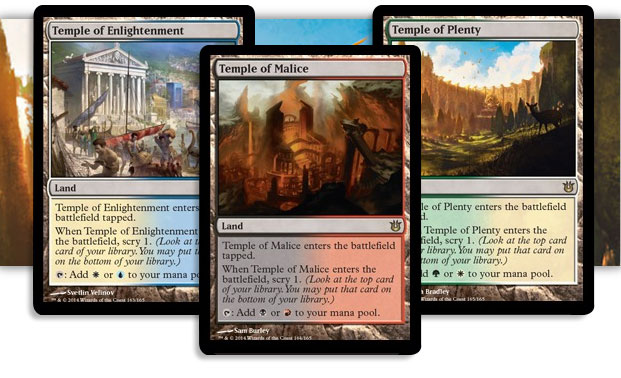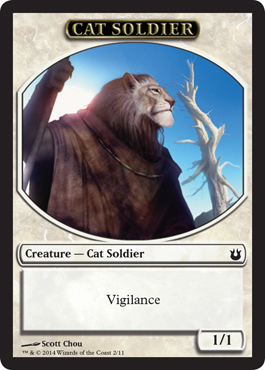Born to be Compiled, Part 2
Last week, I started sharing some card-by-card design stories from Born of the Gods. As I only made it to M (and well, called it "Part 1"), today will be the second part. But enough exposition, let's continue with the stories.
Last week, I talked about how designers plan ahead with mechanics. Nyxborn Shieldmate and others like it are a good example. When we decided to pull bestow back to Theros (remember that it was originally slated to be introduced in Born of the Gods), I made the call to restrict the bestow creatures in Theros to what Ramp;D calls "square stats." That's just a fancy way of saying the power and toughness always match.
The reason I did that was twofold. First, bestow was the most complex mechanic we had in the block. While it was the glue that held everything together, I knew it had the potential to make the set hard to learn. Part of sticking to square stats was just to lessen the complexity. I know non-square stats might not sound like much complexity but we have found time and again that it adds up, especially when you have numerous bestow creatures on the battlefield to keep track of.
Second, we wanted to make sure that the cards in Born of the Gods didn't have too much text. One of the problems about the second and third sets in the block is that the first set often makes use of the easiest applications of the mechanics, making later sets ramp up in wordiness and complexity. Non-square stat bestow creatures allowed us to do something new that required the minimum amount of rules text.
For those two reasons, we held off the non-square stats for Born of the Gods.
I often talk about aesthetics because I believe deeply that things in games have to feel right. Ornitharch is an example of a very aesthetic card that makes me happy when I see it in the set. Tribute is about the opponent making a choice, always a bad choice between two sucky options, when your creature enters the battlefield.
Whenever a card requires a player to pick one of two choices, I like for the two choices to feel connected to one another. I talked about this last week with cards with two modes, but I feel it applies to any card with two components. Ornitharch offers the player the following decision: "I am going to have 5 power of creatures. You get decide how I get them." In short, the owner of Ornitharch is going to pull two glass beads out of his or her bag. Are those +1/+1 counters or creature tokens?
It might seem that each time I examine the aesthetic of a card that it's not a big deal, but I swear that the difference between a game feeling great and just okay can boil down to just a couple subtle decisions on a few cards. I also know this because whenever we mess up the aesthetics, I never hear the end of it. (Griselbrand, I'm looking at you.)
I often talk about how Magic is many different games all sharing a single rules system. Perplexing Chimera is a good example of a card that is designed with a particular game in mind but made broad enough that it can have other applications. Perplexing Chimera is what we in design call a traveling card. The goal of a traveling card is to keep moving from player to player.
Why would you want to do this? A traveling card's primary goal is to add spice to multiplayer games. It allows one player to essentially add a card that the entire group will have the pleasure of playing. Traveling cards, by nature, are a little bit more about the journey than the destination. They both add in some whimsy and force players to interact, but they tend to increase variance rather than lower it.
Traveling cards are very niche, which is why we don't make many of them, but they are a commodity where a little can go a long way for the players who love them.
One of the roles of the second set in a block is to continue the themes of the first set. Last week, I talked about how I wanted Minotaur tribal to be part of the block, and Ragemonger is in Born of the Gods to help continue this theme. As Theros block pushes Minotaur tribal in a new direction (Minotaurs are in red and black in this block—Minotaurs have also been in white and blue in past sets), Ragemonger was a little more focused to be not just for any Minotaur deck, but a black-red one.
Ragemonger also has a secondary goal of trying to help make Minotaurs a little cheaper to help get them out quicker. As I also talked about last week, the creative team's need to keep Minotaurs a little larger, power/toughness-wise, tended to push the Minotaurs up in mana costs. Ragemonger is trying to help adjust this.
This card was originally designed very early during Theros design. It is making reference to Romulus and Remus, two characters central to the myth of the founding of Rome. Abandoned as babies, the twins survive partly by being raised for a short period by a wolf. We were trying to find as many Greek and Roman myths as possible to riff off of, so Romulus and Remus seemed as good as any other.
But then the creative team came to us and said they wanted to focus on the Greek mythology and hold off on the Roman influences for a different future set. The design team said fine and started purging the file of Roman influences. I knew Raised by Wolves was Roman inspired, but I let it stay in the file for a while because everyone on the team liked it so much. Finally, one day, I was squeezed at green uncommon and decided that it was finally time to face up to the fact that Raised by Wolves didn't quite fit, so I removed it from Theros.
When Born of the Gods design started up, Ken looked back through all the cards that had been cut from Theros. As I often explain, many cards get removed not because they aren't good but simply because they conflict with other cards in the file or simply lose out to numbers. This means that there are often good cards found in this pile of discarded cards, so the lead designers of the second and third sets in the block have learned to look at it.
Ken liked Raised by Wolves so he put it into Born of the Gods. I told him that the card was actually referencing a Roman myth and not a Greek one, but Ken felt that the card could stand on its own and didn't need to directly tie to any particular myth. I said it was okay as long as the creative team was okay with it, and obviously it was, so Raised by Wolves made it to print.
I often talk about different aspects of block planning, but here's one I don't think I've mentioned. One of the things blocks do is introduce new threats to the game. Part of the fun of exploring a new set is finding new ways to win. With Theros, one of the most high-profile new routes to victory are the Gods. To keep the Gods from being too easy to deal with, we chose to make them indestructible. There's just one small issue with that. Almost all enchantment removal cards are destruction effects.
We were fine with this early on because we wanted the Gods to make a strong entrance, but as the block evolves, we want to make sure that we are giving different colors means to deal with them. Revoke Existence was specifically designed to allow white to have a tool to handle the Gods. White often exiles creatures, and is the number-one enchantment removal color, so we felt we could combine these two aspects to make a card that gives white an answer to one of the biggest new threats in the block.
Some designs are all about the set in question and some designs are about a larger path of design and development. While most of my card stories are about the former, I like to talk a little bit about the latter. Satyr Wayfinder is one such card.
It's a Satyr, so it's flavored to belong on Theros, but the really important detail of the design is how it's fetching the land. As time progresses, Ramp;D has become less and less fond of shuffling. It takes a significant amount of time (especially in a tournament, where both players usually have to ensure the deck is properly shuffled) and skill (a good number of players have trouble shuffling, particularly with sleeved cards). As such, Ramp;D has tried to lessen how much shuffling is in the game.
For most effects, we've been able to remove or replace them with other non-shuffling effects. Land fetching, though, has proven more problematic because it's an effect we do want in the game and often need at common. Satyr Wayfinder is us exploring land fetching without shuffling. It's not perfect, as you can miss, but we've found that four is a good number, where you hit a vast majority of the time.
Sphinx's Disciple is one of my favorite cards with inspired. The reason I like it is because it uses inspired to recreate a popular unnamed mechanic we do but with a cool twist. The mechanic in question is referred to in Ramp;D as "curiosity." It allows you to draw a card whenever the creature with the ability deals combat damage.
This card isn't exactly curiosity. All it requires to work is that the creature get tapped. That can be through attacking but it doesn't have to be. Also, as the Sphinx's Disciple has flying, it acts in game play, especially in Limited, a lot like a Thieving Magpie, but is just different enough that it allows you to play with it in ways the original effect never could. For example, you could enable the Sphinx's Disciple by enchanting it with a bestow creature that grants it a tap ability.
I talk a lot about how design's job is to deliver the known but with a twist. Sphinx's Disciple neatly fits the bill. It's a lot like a card most players know well but just different enough that you will be able to do things with it you never could with Thieving Magpie.
Two birds, one stone. That's the short version of how this card came to be.
Here's the slightly longer version: One of the two mechanics in the set is inspired. Part of making inspired interesting was making sure that there were enough enablers in the set. We wanted attacking to be one way to get inspired creatures tapped, but not the only way.
Meanwhile, we were looking for ways to help fix mana. As this wasn't a set with a lot of nonbasic lands, we were looking for an artifact or two to help us through. Also, design is always looking out for good reprints. Part of saving design space is not always reinventing the wheel but making use of good wheels from the past. Put these all together and we discovered we had one card that solved all three problems—Springleaf Drum.
Okay, it was three birds.

Development was interested in having scry dual lands. Over the last five years, Ramp;D has made a big shift in how we think about ally and enemy colors. While we still like some cards that help allies or hurt enemies, we've shifted our thoughts about the mana for two-color decks.
Back in the day, we always made ally dual lands easier to acquire than enemy ones. The thought process was that ally colors should be easier to play as it matched the flavor of the color pie. As time has marched on, we realized something important. Restricting enemy dual lands just meant it was harder to play enemy colors and that it limited what players were able to play.
That was making the game less fun and for what trade-off? To slightly further the flavor of allies and enemies. We decided it wasn't worth it and now are more conscious to try and get all ten color pair dual lands. This was just my lengthy way of saying that development wanted the block to have all ten scry lands.
The big question was, who got them when? After some discussion, the decision was to spread them out through the block. The large set would have five, the first small set would have three (it got the extra one to get it out sooner) and the second small set would have two. Development decided to let the Gatecrash color combinations get their dual lands first because they had to go second last year. I don't remember the criteria for the second three other than development wanted to make sure all five colors were represented.
And that is how Born of the Gods got three dual lands.
When I first pitched the idea of bringing back chroma to Erik Lauer, the lead developer of Theros and overall head developer (my equivalent on development), he was a little skeptical. He felt that it required a lot of counting and he wasn't sure the game play was worth it.
After some thinking, I came back and made the following suggestion: What if we don't do static abilities at lower rarities? What if the vast majority of cards with devotion were creatures with an enters the battlefield (ETB) trigger? This meant that you would only have to count once per card. Other than the Gods, which were at mythic rare and powerful enough that the counting mattered, the only other cards with devotion that did not have ETB effects were Karametra's Acolyte and Nykthos, Shrine to Nyx, both with mana-generating activated abilities.
At the time, we had numerous other creatures with devotion, which I pulled from the file. One of them was a creature that had an attack trigger that got +X/+0, where X was your devotion to red. When we got to Born of the Gods and were looking for a few small ways to evolve devotion, I brought up the red creature. I believe it was eventually turned into an Aura because red had too many creatures, so Ken converted it from an effect on a creature to an Aura that granted the ability to a creature.
Like Satyr Wayfinder, Tromokratis is another card where Ramp;D is messing around with a basic part of the game. When we first keyworded untargetability we chose shroud, which made the permanent in question untargetable by everyone—even yourself. We learned with time that a significant number of players were playing shroud assuming they could target it, so we shifted from shroud to hexproof.
Hexproof, though, has proven to be a bit of a problem child. Ramp;D lessened how much we use it and has avoided, at lower rarities, of putting hexproof with evasion. Tromokratis is us experimenting with trying hexproof with restrictions.
The idea behind Tromokratis was one of flavor. If it sits back curled up, it's resistant to magic. But if it ever ventures out, thus losing its defensive stance, it makes itself vulnerable. Game-playwise this worked nicely, because if Tromokratis doesn't attack then it is much less of a threat.
Players' reaction to this hexproof variant will definitely have a bearing on whether we use more of it in the future.
Time to answer a question I'm expecting to get on this card: Why do the Cat creatures have vigilance?
Because of this card:
We didn't want two different Cat tokens that did different things, so since Brimaz made Cats with vigilance, so too must Vanguard of Brimaz.

Which now brings us to the next question. Why do the Cat creatures made by Brimaz have vigilance?
Normally what we do is have the token maker make vanilla tokens and then grant the ability to the tokens through a static ability. We were concerned, though, that granting vigilance to creatures that entered mid-combat would confuse players, so we chose to put the vigilance onto the creature tokens.
Finally, after years, we got Kiora onto a card. To celebrate Kiora's accomplishment, the design team decided to make a card for her. Well, we made her a bunch of Krakens and Serpents and such but what we wanted was a spell. What spell would Kiora love to cast? From the Duels of the Planeswalker deck that inspired her creation (see last week), we knew that she had a love for giant sea creatures. Could we make a large spell that wanted to go specifically into that deck?
Sometimes in design you want to be subtle. You want to craft a card to fill a particular purpose but you want to do so with a gentle hand. Other times, not so much. Whelming Wave was the design team being as unsubtle as possible. Who wants to play this card? Decks with Krakens, Leviathans, Octopuses, or Serpents, preferably many or all of them. Now, that's a spell for Kiora.
Now yes, the spell does have a use for decks without any of these creatures, but where it really shines is in a deck that would make Kiora proud.
When I first came up with the idea of doing gods, I figured out that I wanted three cycles of them, one in each set. The first cycle would be the major monocolored gods, the second would be the ally two-colored gods, and the third would be the enemy two-color gods. It was very orderly and made plenty of mechanical sense. It didn't, though, take into account any of the story. The reason for this is the decision was made before there was a story. Yes, we knew the basic outline, but a lot of details—like, say, who the antagonist of the story was—had yet to be decided.
The creative team then came up with a story they liked where a native of the world became a Planeswalker and figured out a way to transcend to godhood (I'll leave Uncharted Realms to explain how). This meant that Theros needed Xenagos as a Planeswalker and then Born of the Gods needed him as a God. It also meant that Theros was going to start with only fourteen gods.
There was some talk about whether we were supposed to state there was only fourteen gods and not point out how the gods were going to play across the block, but the whole reason for the fifteen-god structure was to make sure every set had its own mythic rare cycle of gods, so we stayed kind of mum on what exactly was going on with the gods. For those who paid attention, the flavor text in Theros only makes reference to fourteen gods.
But we announced that Born of the Gods had five gods (although we didn't announce which ones) so we left a lot of balls in the air knowing that once we previewed Xenagos that all would be explained.
Xenagos is also a rarity in that the character shows up twice in the block but on two different types of cards. While we have done new versions of legendary creatures in the past, and changed things like color or creature type, we have yet to change the creature's card type, so Xenagos is definitely breaking new ground. I hope you have fun playing him in whatever form or forms you choose.
- Born Free
That's all the time we have for today. I hope my two-week jaunt through the cards was informative and entertaining. As always, I would love to hear your feedback on any of the topics I brought up through my email, the thread to this column, or through my social media (Twitter, Tumblr, Google+, and Instagram).
Join me next week when I'll get inspired.
Until then, may Born of the Gods bring many stories to share.
- "Drive to Work #92—Mailbag with Matt #1"
This is my very first mailbag column with my special carpool guest, Matt Cavotta (somebody had to select and read the questions).
- "Drive to Work #93—Top Down Design"
My second podcast this week is a look at how we design when we start from the flavor—what we refer to as top-down design.
Multi |
- Episode 93: Top Down Design (14.1 MB)
- Episode 92: Mailbag with Matt #1 (15.8 MB)
- Episode 91: Names (19.2 MB)
- Episode 90: Stages of Design (22.7 MB)
- Episode 89: Theros, Part 8 (29.9 MB)
- Complete Drive To Work Podcast Archive



@maro254
Email Mark
Author Archive
Making Magic Archive
Working for Magic Ramp;D since October, 1995, Mark Rosewater is currently the head designer. His hobbies include spending time with his family, talking about Magic on every known medium (including a daily blog and a weekly podcast), and writing about himself in the third person.



